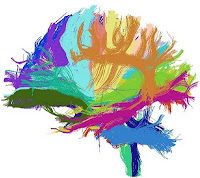The brain is normally ‘secured’ from the circulating blood directly, so that endogenous and exogenous toxic substances, macromolecules can not gain entry easily into (and out of) the brain. More importantly, this ‘firewall’ like barrier, called the ‘blood brain barrier’ maintains the constancy of ions inside the brain such as K+, H+, Mg++, Ca++, which is vitally important for the neurons to function normally.
The ‘blood brain barrier’ (BBB: see picture) results from the ‘relative’
 impermeability of both the capillaries supplying the brain as well as that of the ‘choroid plexus’ covering the brain. Actually, the endothelial cells of the capillaries are tightly packed (tight junctions) and they are non-fenestrated too. In addition, end feet of astrocytes, a type of glial cells (cells that support and aid neurons), cover these capillaries.
impermeability of both the capillaries supplying the brain as well as that of the ‘choroid plexus’ covering the brain. Actually, the endothelial cells of the capillaries are tightly packed (tight junctions) and they are non-fenestrated too. In addition, end feet of astrocytes, a type of glial cells (cells that support and aid neurons), cover these capillaries.But there are disease conditions in which the BBB becomes leaky. For example, in traumatic brain injury, cardiac arrest, stroke and multiple sclerosis the blood brain barrier is breached, to different extents. In Alzheimer’s disease too, there is thinning of the capillaries as the disease progresses. As expected, the supporting glial cells, particularly the astrocytes, jump into action to seal the leaks. They proliferate, resulting in ‘gliosis’. Gliosis is also found in a tumorous condition of the glial cells called ‘glioma’.
These glial cells contain a protein in them called the glial fibrillary acidic protein (GFAP). Naturally, there is an mRNA for it that ‘translates’ its formation in the cytoplasm. Scientists target this mRNA molecule because tagging it will track the GFAP and consequently the astrocytes in whom GFAP is expressed.
Previously scientists had to inject MR contrast agents intra-cerebro-ventricularly or by other invasive techniques to map these leaking areas. Scientists at Harvard embarked on a novel idea. They produced a short cDNA sequence ‘complementary’ to the mRNA of GFAP. This short stretch of this ‘antisense’ oligodeoxynucleotide (ODN-gfap) would latch onto the GFAP mRNA just as a lock would to its key. They then tagged it with a paramagnetic molecule that they designed, called superparamagnetic iron oxide nanoparticles or SPION, a magnetic resonance susceptibility contrast agent. The SPION-ODN ‘report’ any inhomogeneity in transverse magnetization in ‘T2 star’weighted MRI scan, due to the paramagnetic properties of iron oxide. Liu et al also used a sequence complementary to the mRNA of beta-actin as well (actin is the most abundant protein in mammalian cells and its mRNA is found in all types of cells) to act as a ‘control probe’.
They then anesthetized the mice, the animal model they selected; and caused BBB leakage by inflicting a small puncture or by performing bilateral carotid artery occlusion (BCAO) for 60 minutes. They also tried other methods (see reference). They subjected another group of mice to a sham (=false) operation (no puncture or vessel occlusion but the same operation) at the same time. BBB leakage was checked by T1 weighted Gadolinium-DTPA contrast MRI scan. Gd-DTPA was injected into the jugular veins of the mice. Leakage would show up as enhanced areas on T1 weighted scan (normally Gd-DTPA does not cross the BBB). Due to repair process to seal the leak, glial cells would be recruited and gliosis would result.
The telltale signature of gliosis (and BBB breach) may be found in postmortem tissue samples of the brain. Previously, the GFAP antigen was detected by immunohistochemical methods. But the Harvard team was looking for a non invasive method to detect GFAP. They instilled ‘SPION-ODN gfap’ reporter into the conjunctival sac of the mice by means of eyedrops. They then measured the ‘T2 star’ values in MRI scan and transformed the values to ‘R2 star’ maps (R2 star = 1/T2 star). Areas of leakage showed up as elevated (hyperintense) signals in R2 star maps. It corroborated well with Gd-DTPA scans and also on post mortem examination. SPION-beta actin, the control probe, got bound to the endothelial cells of the vasculature as expected.
The eye drop was absorbed by the lymphatics draining the palpebral (eyelid) and bulbar conjunctiva. The lymphatics then transferred the reporter probe into the veins which finally found their way into the brain. Since the BBB was breached, it finally came out of the circulation into the brain parenchyma. As the probe is detecting mRNA which is ‘transcribed’ from the DNA of the cell, it may be said that they are, in a sense, detecting the genes for GFAP.
Thus we may hope to detect gliosis, a pathology that occurs in a variety of diseases already mentioned, non invasively, the ophthalmic way.
Last modified: never
Reference: Liu, C., You, Z., Ren, J., Kim, Y., Eikermann-Haerter, K., & Liu, P. (2007). Noninvasive delivery of gene targeting probes to live brains for transcription MRI The FASEB Journal, 22 (4), 1193-1203 DOI: 10.1096/fj.07-9557com


